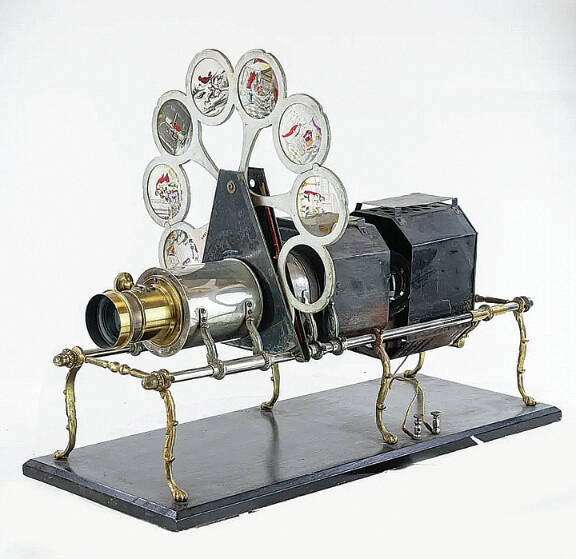According to science fiction author Arthur C. Clarke, “any sufficiently advanced technology is indistinguishable from magic.”
Look at magic lanterns, which even have “magic” in their name. They were used in Europe by the 1650s. Traveling showmen used them to apparently conjure ghosts and demons out of thin air to the shock and amusement of their audiences. Of course, these apparitions were projected by candlelight through the lantern’s lens.
Audiences loved these devices, and over time, they received improvements and became more accessible. Oil and gas lamps replaced the candle, and glass slides projected colorful images instead of shadows. By the mid-1800s, the magic lantern had a new name: the stereopticon, a technical-sounding term referencing the scientific concepts behind its operation.
Some manufacturers called them sciopticons, arguably putting even more emphasis on the scientific aspects. One sciopticon model, patented by the Pettibone Manufacturing Company of Cincinnati, Ohio, in 1888, was known as the “Peacock,” thanks to the revolving discs holding the painted glass slides, which resembled a peacock’s fanned-out tail.
This Peacock sciopticon sold at Donley Auctions for $1,845. It has an electric light, showing further advances in technology, and includes two discs. By the time this style of sciopticon appeared, popular subjects for slides included famous stories, historical figures, morality tales, exotic scenery and scientific illustrations. A far cry from the shadowy ghosts and ghouls of the 17th century, the magic lantern had developed into an educational tool.
Q: Can you tell me about what I call a “foot stool”? It belonged to my grandparents born 1883 and died 1969, married in 1910. After their death, it went to my aunt (all lived in Grand Rapids, Michigan) and after her death, I inherited it in 2008. I have no idea when it was purchased and have recovered it. There are no markings on it and no damage. The solid wood cylinder is 4 inches wide, 14 inches in circumference and 13 inches long. It stands 9 inches tall with four 6-inch feet at an angle, and with two 3-inch-long knobs at each end to make it about 20 inches long total. Everyone who sees it remarks how interesting it is!
A: Your foot stool sounds like a gout stool. Gout is a form of arthritis that can cause joint pain, especially in the ankles and toes. In the 18th and 19th centuries, there were several styles of gout stools, designed to deep weight off the feet and relieve the pain. Some were made like miniature rockers. Yours sounds like a “rolling pin” type, so-called because of its shape. Some of them had features like a rotating cylinder to massage the foot or ankle, or adjustable legs to get the stool to the right height for different users. Some are still made today. Antique gout stools by unknown makers usually sell for under $100.
Q: I inherited a gouache, and I’ve just found out it’s an original photochrom by Detroit Photographic Co., copyright 1899. The subject is Gustav Wertheimer’s The Kiss of the Wave, and my antique dealer says its technique is exemplary. I’d like to know more about it.
A: The Detroit Photographic Co. was founded in the 1890s in Detroit as a photographic publisher. The company soon obtained rights to the Photochrom process (sometimes spelled “Photochrome”) for creating colorized images from a black-and-white photographic negative. This process, a variant of chromolithography, was invented in the 1880s in Switzerland. The photographic negative was transferred onto printing plates. A print could be made with as many as 25 plates: one for each color. The photographer would have had to record the subject’s colors onsite, often with a watercolor sketch. The completed photochrom would look like a color photograph, but if you inspect it with a magnifying glass, you will see the small dots of color created by the printing process. Popular subjects included foreign scenery, travel destinations, and, like yours, copies of famous works of art. Gustav Wertheimer (1847-1902) was an Austrian painter known for his dramatic historical and mythological scenes. Photochroms sell at antique shops and auctions, and their value usually depends on their size. Postcard-size pieces can sell for about $50; larger sizes go for between $150 to $300.
TIP: Never laminate a paper collectible, whether it’s a document, photo, letter, press pass, cut autograph, or baseball card. Lamination is permanent and permanently decreases value.
On the block
Current prices are recorded from antiques shows, flea markets, sales and auctions throughout the United States. Prices vary in different locations because of local economic conditions.
Box, candle, mahogany, slide lid, two notches at front, lower drawer, dovetail construction, late 1800s, 6 by 11 inches, $65.
Silver plate, dresser box, mechanical, top handle, two doors, silk lining, lily of the valley, pierced scrolls, four-footed, quadruple plate, Victorian, $75.
Bottle, snuff, porcelain, figural, grasshopper, enamel, gilt, tiger’s eye cabochon stopper, four-character Qianlong mark, Chinese, 3½ inches, $140.
Mt. Washington, saltshaker, cockle shell shape, ivory to white, yellow and pink enameled flowers, 2½ inches, $165.
Sandwich glass, toy, flat iron, figural, amethyst, wheel molded, factory polished, circa 1860, 1¼ inches, $285.
Advertising, sign, Columbia Grafonolas and Records, yellow ground, cabinet model, black lettering, orange outline, dealer, Cole Camp, Missouri, lithographed tin, circa 1910, 14¼ by 21¼ inches, $510.
Watch, Royce, lapel, figural, grandfather clock shape, garnet pendulum, decorative weights, rubies, diamond, square dial, 14K gold, women’s, 2½ by 1¼ inches, $705.
Lamp, chandelier, 18-light, gilt bronze, tulip-shaped cups, bobeches, leafy scrolled arms, acanthus center, electrified, France, early 1900s, 30 by 30 inches, $960.
Furniture, table, Victorian, cherry, carved, two side panels, North Wind face, rope twist carved legs, lower shelf, ball and claw feet, casters, late 1800s, 32 by 46 by 29½ inches, $1,000.
Rug, Grenfell, pictorial, three Canada geese, flying, pine trees, shaded orange ground, label, circa 1925, 26½ by 40 inches, $1,375.
Talk to us
> Give us your news tips.
> Send us a letter to the editor.
> More Herald contact information.

























